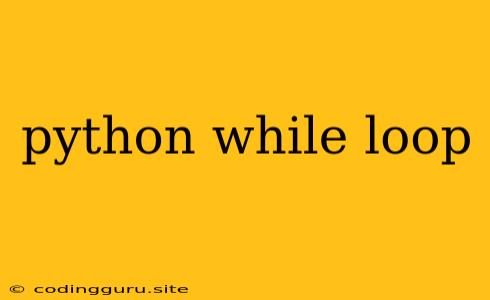The Power of Repetition: Understanding Python's while Loop
In the realm of programming, repetition is a fundamental concept. It's the ability to execute a block of code multiple times, saving you from writing the same code over and over again. Python, a versatile language, offers several ways to achieve repetition, with the while loop being a key player.
What is a Python while Loop?
Imagine a scenario where you need to repeat a task until a specific condition is met. This is where the while loop comes into play. It's a control flow statement that allows you to execute a block of code repeatedly as long as a given condition remains true.
The basic syntax of a while loop in Python is:
while condition:
# Code to be executed repeatedly
The loop will continue to run as long as the condition evaluates to True. Once the condition becomes False, the loop terminates, and the program continues with the code following the loop.
A Simple Example:
Let's say you want to print the numbers from 1 to 5 using a while loop:
count = 1
while count <= 5:
print(count)
count += 1
In this example:
- We initialize a variable
countto 1. - The
whileloop checks ifcountis less than or equal to 5. - If the condition is true, the code inside the loop executes, printing the current value of
count. - The
countvariable is then incremented by 1. - The loop repeats steps 2 to 4 until
countbecomes 6, at which point the condition becomes false, and the loop ends.
The Importance of the condition:
The condition in a while loop is crucial. It determines how many times the loop will execute. If the condition never becomes false, the loop will run indefinitely, potentially causing a program to hang.
When to Use a while Loop:
- Unknown Number of Iterations: When you don't know in advance how many times you need to repeat a task, a
whileloop is ideal. - Looping Until a Condition is Met: If you need to keep looping until a specific condition is satisfied, a
whileloop is the way to go. - User Input: When you need to repeatedly take input from the user until they provide valid input, a
whileloop helps.
Tips and Considerations:
- Infinite Loops: Be cautious with
whileloops. If the condition never evaluates toFalse, you'll create an infinite loop, potentially causing your program to crash. - Indentation: Python relies heavily on indentation. Make sure the code inside the
whileloop is properly indented to ensure it's part of the loop. - Break Statement: You can use the
breakstatement to exit awhileloop prematurely, even if the condition is still true. - Continue Statement: The
continuestatement skips the remaining code in the current iteration of the loop and jumps to the next iteration.
Examples of while Loop Applications:
- Validating User Input: You can use a
whileloop to repeatedly prompt the user for input until they provide valid data, such as a number within a specific range. - Game Development:
whileloops are essential for game loops, which handle game logic, rendering, and user input. - Data Processing: You can use a
whileloop to iterate through a data set and perform operations until a specific condition is met.
Conclusion:
The while loop is a powerful tool in Python that provides a flexible and efficient way to handle repetitive tasks. Understanding its syntax, usage scenarios, and potential pitfalls is crucial for building robust and effective Python applications. Whether you're validating user input, controlling game logic, or processing data, the while loop empowers you to write code that executes tasks efficiently and repeatedly.
